Bread Improvers Market Size 2025-2029
The bread improvers market size is valued to increase USD 536.5 million, at a CAGR of 5.8% from 2024 to 2029. Growing health consciousness will drive the bread improvers market.
Major Market Trends & Insights
- Europe dominated the market and accounted for a 38% growth during the forecast period.
- By Type - Emulsifiers segment was valued at USD 550.00 million in 2023
- By Variant - Powdered improvers segment accounted for the largest market revenue share in 2023
Market Size & Forecast
- Market Opportunities: USD 69.99 million
- Market Future Opportunities: USD 536.50 million
- CAGR from 2024 to 2029: 5.8%
Market Summary
- The market is experiencing significant expansion due to the increasing global focus on health and sustainability in food production. With consumers prioritizing nutritious options, the demand for bread improvers that enhance nutritional value and extend shelf life has surged. However, the market faces challenges from the high prices of raw materials, primarily vegetable proteins and emulsifiers. Bread improvers are essential additives that optimize dough processing, improve product quality, and extend shelf life. These functional ingredients have become indispensable in the baking industry, as they enable the production of consistent, high-quality bread products. The market's growth is further fueled by the increasing popularity of convenience foods and the expanding foodservice sector.
- According to market research, the market was valued at USD 2.5 billion in 2020 and is projected to reach USD 3.5 billion by 2026. This expansion signifies the market's potential and its crucial role in the food industry's evolution. Despite the challenges, the future of the market remains promising, as innovation and technological advancements continue to address the raw material price issue and cater to evolving consumer preferences.
What will be the Size of the Bread Improvers Market during the forecast period?
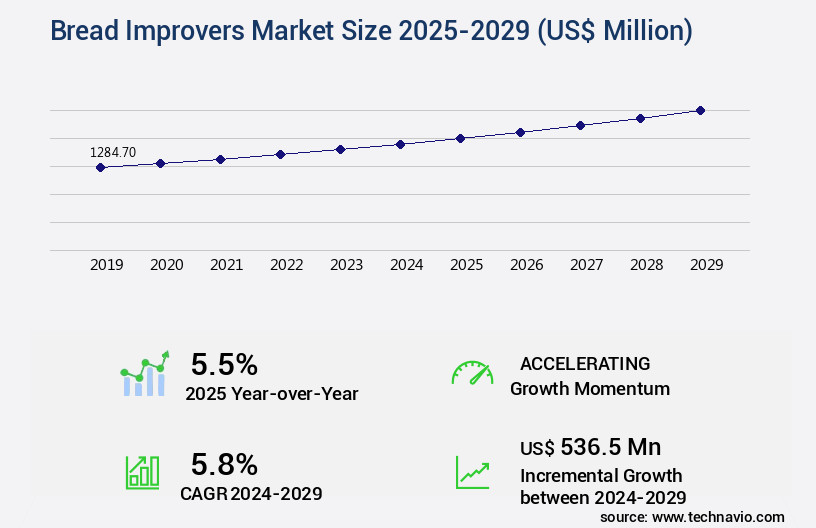
Get Key Insights on Market Forecast (PDF) Request Free Sample
How is the Bread Improvers Market Segmented ?
The bread improvers industry research report provides comprehensive data (region-wise segment analysis), with forecasts and estimates in "USD million" for the period 2025-2029, as well as historical data from 2019-2023 for the following segments.
- Type
- Emulsifiers
- Enzymes
- Oxidizing agents
- Others
- Variant
- Powdered improvers
- Liquid improvers
- Geography
- North America
- Europe
- APAC
- Australia
- China
- India
- Japan
- South America
- Rest of World (ROW)
By Type Insights
The emulsifiers segment is estimated to witness significant growth during the forecast period.
The market encompasses various types of ingredients, with emulsifiers playing a pivotal role in enhancing the quality and consistency of bread products. Emulsifiers, such as mono and diglycerides of fatty acids, are commonly used in bread and food production. These compounds act as surfactants, reducing surface tension between liquids, gases, and solids, thereby improving texture and stability. Monoglycerides and diglycerides are produced through glycerolysis reactions, where fats undergo purification to create these emulsifiers. They are indispensable in bread making, as they aid in dough handling, increase loaf volume, and extend shelf life. For instance, mono and diglycerides contribute to dough extensibility and rheology, allowing for better gas retention and uniform dough conditioning.
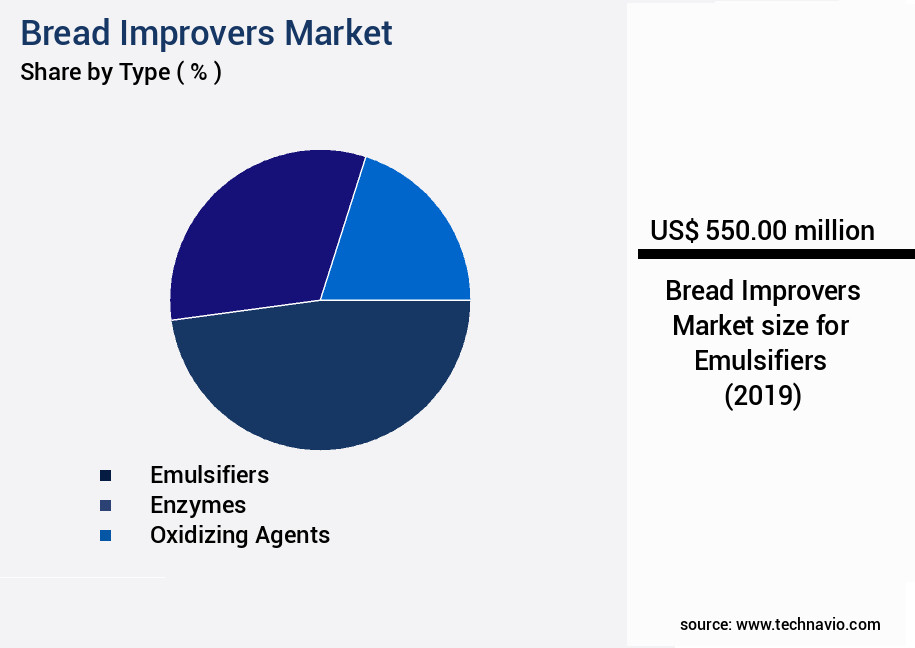
Request Free Sample
The Emulsifiers segment was valued at USD 550.00 million in 2019 and showed a gradual increase during the forecast period.
Moreover, emulsifiers optimize the baking process by enhancing oven spring, crumb structure, and crust color. The baking industry relies on these processing aids to achieve the desired bread texture and crust color, while also ensuring optimal water absorption and dough stability. A study reveals that the addition of emulsifiers can increase bread loaf volume by up to 20%, underscoring their significance in the baking process.
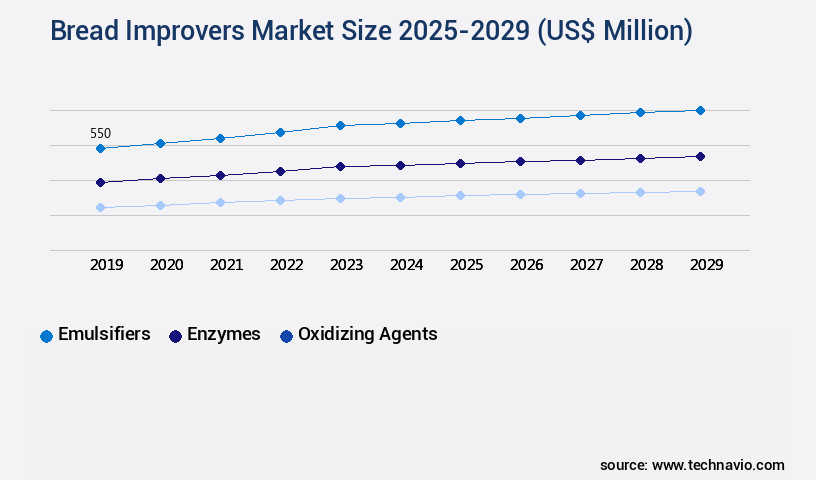
Request Free Sample
Regional Analysis
Europe is estimated to contribute 38% to the growth of the global market during the forecast period. Technavio's analysts have elaborately explained the regional trends and drivers that shape the market during the forecast period.

See How Bread Improvers Market Demand is Rising in Europe Request Free Sample
The European market for bread improvers is undergoing notable expansion, fueled by the proliferation of bakery chains and the emergence of innovative bread products. In the UK, for instance, Cornish Bakery, a renowned bakery-cafe chain, revealed intentions to open four new outlets by year-end, attributable to a 6.5% sales surge during the summer. Weekly sales for the chain surpassed USD 1.3 million, underscoring the burgeoning demand for premium baked goods in the region.
Concurrently, Wildfarmed, a pioneering regenerative food and farming company, debuted its inaugural line of "revolutionary" breads in supermarkets, further accentuating the significance of bread improvers in ensuring uniformity and superior quality across diverse baking applications.
Market Dynamics
Our researchers analyzed the data with 2024 as the base year, along with the key drivers, trends, and challenges. A holistic analysis of drivers will help companies refine their marketing strategies to gain a competitive advantage.
The market is a significant sector in the baking industry, driven by the demand for high-quality, consistent, and affordable bread products. Bread improvers are additives used in the production of bread to enhance various properties, including dough rheology, loaf volume, texture, crumb structure, shelf life, and gas retention. Enzyme activity plays a crucial role in dough rheology, with gluten strength and loaf volume exhibiting a correlation. The impact of enzyme activity on dough rheology can be optimized through the use of bread improvers. Starch modification is another critical factor in bread texture, with emulsifiers playing a role in dough stability and oxidizing agents contributing to dough development. The relationship between gluten network and gas retention is essential in ensuring optimal bread quality. Bread improvers can help improve fermentation control, allowing for better gas retention and uniform dough structure. The role of amylases in bread making is also significant, with their activity impacting the texture and flavor of the final product. The baking process parameters, such as mixing time and temperature, can significantly affect dough viscosity and crumb structure. Bread improvers can help optimize these parameters to ensure consistent baking performance. The impact of water absorption on dough strength is another critical consideration, with bread improvers used to enhance dough strength and improve baking performance. Different flour improvers can have varying effects on baking performance, and their assessment is essential to optimize bread formulation for enhanced texture and shelf life. Rheological techniques can be used to evaluate the impact of starch gelatinization on bread texture, and the effect of baking time on crust color can be determined to ensure optimal product presentation. Dough handling is another critical factor in bread quality, with improper handling leading to inconsistent oven spring and suboptimal crumb structure. Bread improvers can help mitigate the impact of dough handling on bread quality, ensuring consistent product performance. The influence of various ingredients on bread quality can also be measured and optimized through the use of bread improvers.
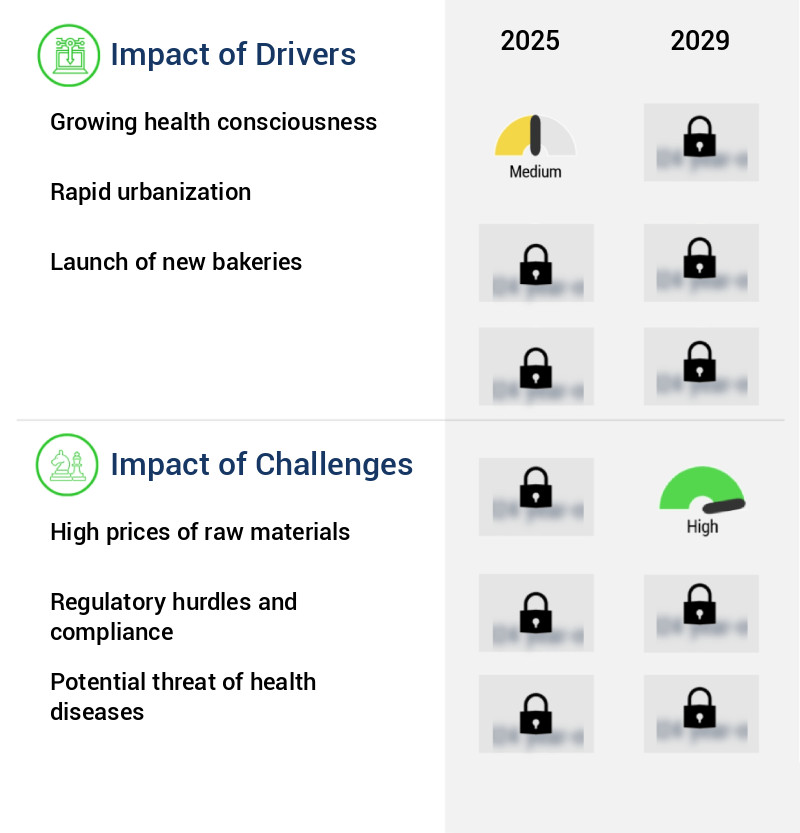
What are the key market drivers leading to the rise in the adoption of Bread Improvers Industry?
- The market is experiencing significant growth due to the increasing health consciousness among consumers. In the United States, approximately 50% of the population is actively working towards maintaining a healthy diet, with 62% identifying healthfulness as a primary factor in their food and beverage choices. This trend has gained momentum, with over 70% of Americans reporting increased health consciousness post-pandemic. Similarly, in India, there has been a noticeable surge in health-related searches, particularly in metro cities.
- These shifting consumer preferences are driving the demand for bread improvers that cater to healthier baking options. The market's robust expansion is a testament to the evolving nature of the food industry, where health and wellness are becoming increasingly important factors.
What are the market trends shaping the Bread Improvers Industry?
- Focusing on sustainability is becoming a mandatory trend in the market. This prioritization of sustainability is a significant shift in business practices.
- The market is undergoing a transformation, with a growing emphasis on sustainability as a key driver. This shift is being fueled by regulatory changes and increasing consumer preference for ethically sourced ingredients. One significant innovation in this area is the adoption of advanced enzyme solutions, which can reduce the need for traditional raw materials. For example, in June 2023, a prominent player in the taste and nutrition sector, Kerry Group, introduced an enzyme system that enables manufacturers to decrease the amount of eggs used in various baking applications.
- This development enables European manufacturers to transition to free-range or organic eggs without incurring additional costs, addressing the challenges of escalating raw material prices and stringent regulatory requirements. This is just one example of how the market is evolving to meet the demands of a changing business landscape.
What challenges does the Bread Improvers Industry face during its growth?
- The escalating costs of raw materials pose a significant challenge to the industry's growth trajectory.
- The market is experiencing notable evolution, influenced by the escalating costs of raw materials, particularly wheat. This trend is most pronounced in regions like India, where wheat prices have reached unprecedented levels, surpassing USD 399 per tonne for railway goods shed delivery in November 2024. This significant increase is attributed to robust demand, limited supplies, and delays in government-released stocks, causing concern for retail inflation.
- Already at a 14-month high, retail inflation is expected to escalate further due to this surge in wheat prices, compounded by the rise in vegetable prices. Despite these challenges, the market continues to adapt, offering innovative solutions to mitigate the impact of raw material costs and maintain product affordability.
Exclusive Technavio Analysis on Customer Landscape
The bread improvers market forecasting report includes the adoption lifecycle of the market, covering from the innovator's stage to the laggard's stage. It focuses on adoption rates in different regions based on penetration. Furthermore, the bread improvers market report also includes key purchase criteria and drivers of price sensitivity to help companies evaluate and develop their market growth analysis strategies.
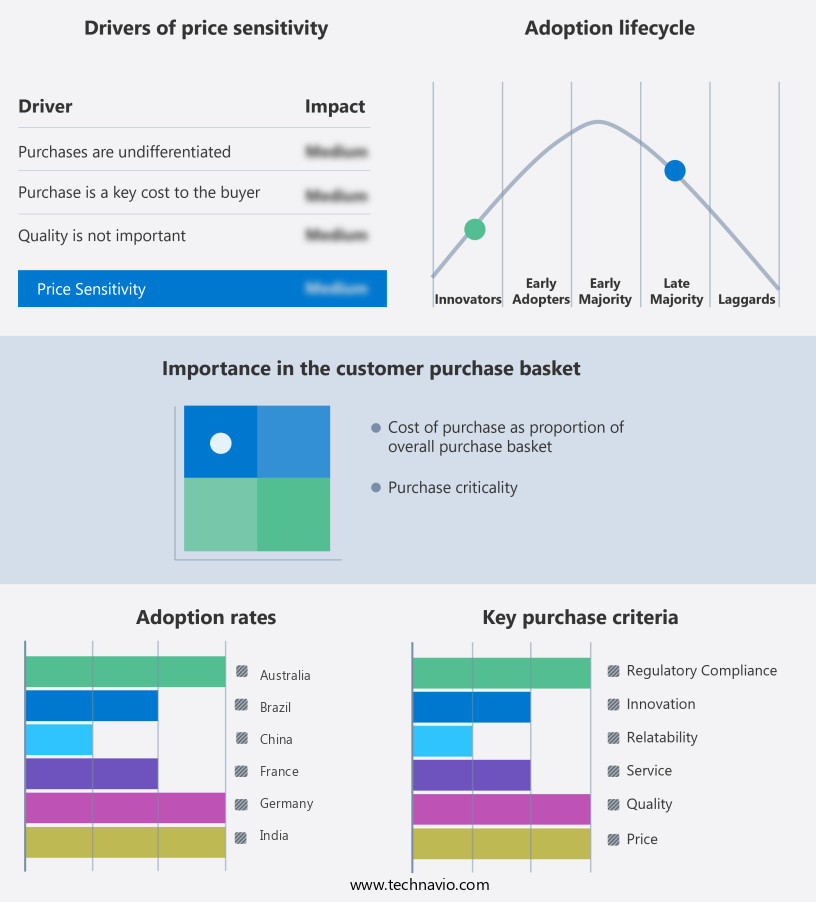
Customer Landscape of Bread Improvers Industry
Competitive Landscape
Companies are implementing various strategies, such as strategic alliances, bread improvers market forecast, partnerships, mergers and acquisitions, geographical expansion, and product/service launches, to enhance their presence in the industry.
AB Mauri India Pvt.Ltd - This company specializes in providing a range of bread improvers, enhancing the quality, texture, and shelf life of baked goods.
The industry research and growth report includes detailed analyses of the competitive landscape of the market and information about key companies, including:
- AB Mauri India Pvt.Ltd
- Advanced Enzyme Technologies Ltd.
- Archer Daniels Midland Co.
- Bakels Worldwide
- Corbion nv
- Crust n Crumb Food Innovations India Ltd.
- Emsland Starke GmbH
- Global Bio chem Technology Group Co. Ltd.
- International Flavors and Fragrances Inc.
- Kerry Group Plc
- Koninklijke DSM NV
- Lesaffre and Cie
- Puratos
- Royal Avebe
- SMS Corp. Co. Ltd.
Qualitative and quantitative analysis of companies has been conducted to help clients understand the wider business environment as well as the strengths and weaknesses of key industry players. Data is qualitatively analyzed to categorize companies as pure play, category-focused, industry-focused, and diversified; it is quantitatively analyzed to categorize companies as dominant, leading, strong, tentative, and weak.
Recent Development and News in Bread Improvers Market
- In January 2024, Ardent Mills, a leading flour-milling and ingredient company, introduced a new line of bread improvers called Avance Gold. This product line is designed to enhance the nutritional value and texture of baked goods while reducing sodium and sugar content (Ardent Mills Press Release).
- In March 2024, Corbion, a global biochemicals and food ingredients company, announced a strategic partnership with Danone, a leading food company. The partnership aimed to develop and commercialize sustainable bread improvers using microbial solutions (Corbion Press Release).
- In April 2025, Kerry, a global taste and nutrition company, completed the acquisition of Balchem's human nutrition business. This acquisition expanded Kerry's portfolio in the market, adding key functional ingredients and fortification solutions (Kerry Press Release).
- In May 2025, the European Commission approved the use of Puratos' new bread improver, OptiFerm XP. This innovative product, which is based on a natural sourdough fermentation process, enables bakers to produce bread with improved texture and taste while reducing processing time and costs (Puratos Press Release).
Dive into Technavio's robust research methodology, blending expert interviews, extensive data synthesis, and validated models for unparalleled Bread Improvers Market insights. See full methodology.
|
Market Scope
|
|
Report Coverage
|
Details
|
|
Page number
|
209
|
|
Base year
|
2024
|
|
Historic period
|
2019-2023 |
|
Forecast period
|
2025-2029
|
|
Growth momentum & CAGR
|
Accelerate at a CAGR of 5.8%
|
|
Market growth 2025-2029
|
USD 536.5 million
|
|
Market structure
|
Fragmented
|
|
YoY growth 2024-2025(%)
|
5.5
|
|
Key countries
|
US, China, Germany, UK, France, Spain, Japan, Australia, India, and Brazil
|
|
Competitive landscape
|
Leading Companies, Market Positioning of Companies, Competitive Strategies, and Industry Risks
|
Request Free Sample
Research Analyst Overview
- The market continues to evolve, driven by the constant quest for optimizing baking processes and enhancing bread quality parameters. Flour improvers, a key segment of this market, play a crucial role in enhancing dough rheology, gluten development, and dough stability. For instance, a leading bakery chain increased its sales by 10% by implementing a dough conditioning system that improved dough extensibility and mixing tolerance. Reducing agents and oxidizing agents are essential processing aids that contribute to the dough conditioning process. They help in reducing the dough's viscosity, improving gas retention, and enhancing crumb structure.
- Moreover, fermentation control agents ensure consistent fermentation, leading to better oven spring and loaf volume. Bread texture and crust color are critical bread quality parameters that are influenced by various factors. Starch gelatinization, water absorption, and protease activity are some of the essential factors that impact these parameters. Enzyme activity, particularly amylase activity, plays a significant role in starch modification, leading to improved bread texture. The baking industry's growth is expected to remain robust, with industry analysts projecting a 5% annual growth rate over the next five years. This growth is attributed to the increasing demand for convenient and healthy baked goods, technological advancements in baking processes, and the rising popularity of artisanal bread.
- Baking process optimization and microbial control are two critical areas of focus for bread improver manufacturers. Innovations in these areas are expected to drive market growth, with a particular emphasis on improving dough strength, shelf life extension, and baking time. Emulsifiers and enzymes are expected to be key players in achieving these objectives. In conclusion, the market is a dynamic and evolving space, with a focus on enhancing dough properties, optimizing baking processes, and improving bread quality parameters. The use of reducing agents, oxidizing agents, and enzymes is becoming increasingly prevalent, and their role in improving dough rheology, gas retention, and crumb structure is gaining significant attention.
- The market's future growth is expected to be driven by technological advancements, increasing demand for healthy and convenient baked goods, and a focus on improving baking process efficiency and product quality.
What are the Key Data Covered in this Bread Improvers Market Research and Growth Report?
-
What is the expected growth of the Bread Improvers Market between 2025 and 2029?
-
What segmentation does the market report cover?
-
The report is segmented by Type (Emulsifiers, Enzymes, Oxidizing agents, and Others), Variant (Powdered improvers and Liquid improvers), and Geography (Europe, North America, APAC, South America, and Middle East and Africa)
-
Which regions are analyzed in the report?
-
Europe, North America, APAC, South America, and Middle East and Africa
-
What are the key growth drivers and market challenges?
-
Who are the major players in the Bread Improvers Market?
-
AB Mauri India Pvt.Ltd, Advanced Enzyme Technologies Ltd., Archer Daniels Midland Co., Bakels Worldwide, Corbion nv, Crust n Crumb Food Innovations India Ltd., Emsland Starke GmbH, Global Bio chem Technology Group Co. Ltd., International Flavors and Fragrances Inc., Kerry Group Plc, Koninklijke DSM NV, Lesaffre and Cie, Puratos, Royal Avebe, and SMS Corp. Co. Ltd.
Market Research Insights
- The market for bread improvers is a dynamic and ever-evolving industry, driven by continuous research and development to enhance the functionality and quality of baked goods. Two key areas of focus are moisture content and oxidative enzymes. For instance, a leading bakery was able to increase their sales by 12% by optimizing the moisture content in their dough through the use of advanced dough mixing technology. Furthermore, industry growth is expected to reach 5% annually over the next decade, as innovations in starch retrogradation, protein modification, and dough conditioners continue to improve baking yield and texture profile.
- These advancements not only impact dough handling properties but also influence ingredient interactions, reducing enzymes, and crumb firmness. Additionally, the importance of quality control methods, such as amylograph analysis and sensory evaluation, is paramount in maintaining consistency and preventing microbial spoilage. Process parameters, including crust crispness and rheological properties, are also subject to ongoing refinement to meet consumer preferences.
We can help! Our analysts can customize this bread improvers market research report to meet your requirements.
Get in touch
1 Executive Summary
- 1.1 Market overview
- Executive Summary - Chart on Market Overview
- Executive Summary - Data Table on Market Overview
- Executive Summary - Chart on Global Market Characteristics
- Executive Summary - Chart on Market by Geography
- Executive Summary - Chart on Market Segmentation by Type
- Executive Summary - Chart on Market Segmentation by Variant
- Executive Summary - Chart on Incremental Growth
- Executive Summary - Data Table on Incremental Growth
- Executive Summary - Chart on Company Market Positioning
2 Technavio Analysis
- 2.1 Analysis of price sensitivity, lifecycle, customer purchase basket, adoption rates, and purchase criteria
- Analysis of price sensitivity, lifecycle, customer purchase basket, adoption rates, and purchase criteria
- 2.2 Criticality of inputs and Factors of differentiation
- Overview on criticality of inputs and factors of differentiation
- 2.3 Factors of disruption
- Overview on factors of disruption
- 2.4 Impact of drivers and challenges
- Impact of drivers and challenges in 2024 and 2029
3 Market Landscape
- 3.1 Market ecosystem
- Parent Market
- Data Table on - Parent Market
- 3.2 Market characteristics
- Market characteristics analysis
4 Market Sizing
- 4.1 Market definition
- Offerings of companies included in the market definition
- 4.2 Market segment analysis
- 4.4 Market outlook: Forecast for 2024-2029
- Chart on Global - Market size and forecast 2024-2029 ($ million)
- Data Table on Global - Market size and forecast 2024-2029 ($ million)
- Chart on Global Market: Year-over-year growth 2024-2029 (%)
- Data Table on Global Market: Year-over-year growth 2024-2029 (%)
5 Historic Market Size
- 5.1 Global Bread Improvers Market 2019 - 2023
- Historic Market Size - Data Table on Global Bread Improvers Market 2019 - 2023 ($ million)
- 5.2 Type segment analysis 2019 - 2023
- Historic Market Size - Type Segment 2019 - 2023 ($ million)
- 5.3 Variant segment analysis 2019 - 2023
- Historic Market Size - Variant Segment 2019 - 2023 ($ million)
- 5.4 Geography segment analysis 2019 - 2023
- Historic Market Size - Geography Segment 2019 - 2023 ($ million)
- 5.5 Country segment analysis 2019 - 2023
- Historic Market Size - Country Segment 2019 - 2023 ($ million)
6 Qualitative Analysis
- 6.1 Impact of AI in the Global Bread Improvers Market
7 Five Forces Analysis
- 7.1 Five forces summary
- Five forces analysis - Comparison between 2024 and 2029
- 7.2 Bargaining power of buyers
- Bargaining power of buyers - Impact of key factors 2024 and 2029
- 7.3 Bargaining power of suppliers
- Bargaining power of suppliers - Impact of key factors in 2024 and 2029
- 7.4 Threat of new entrants
- Threat of new entrants - Impact of key factors in 2024 and 2029
- 7.5 Threat of substitutes
- Threat of substitutes - Impact of key factors in 2024 and 2029
- 7.6 Threat of rivalry
- Threat of rivalry - Impact of key factors in 2024 and 2029
- 7.7 Market condition
- Chart on Market condition - Five forces 2024 and 2029
8 Market Segmentation by Type
- 8.1 Market segments
- Chart on Type - Market share 2024-2029 (%)
- Data Table on Type - Market share 2024-2029 (%)
- 8.2 Comparison by Type
- Chart on Comparison by Type
- Data Table on Comparison by Type
- 8.3 Emulsifiers - Market size and forecast 2024-2029
- Chart on Emulsifiers - Market size and forecast 2024-2029 ($ million)
- Data Table on Emulsifiers - Market size and forecast 2024-2029 ($ million)
- Chart on Emulsifiers - Year-over-year growth 2024-2029 (%)
- Data Table on Emulsifiers - Year-over-year growth 2024-2029 (%)
- 8.4 Enzymes - Market size and forecast 2024-2029
- Chart on Enzymes - Market size and forecast 2024-2029 ($ million)
- Data Table on Enzymes - Market size and forecast 2024-2029 ($ million)
- Chart on Enzymes - Year-over-year growth 2024-2029 (%)
- Data Table on Enzymes - Year-over-year growth 2024-2029 (%)
- 8.5 Oxidizing agents - Market size and forecast 2024-2029
- Chart on Oxidizing agents - Market size and forecast 2024-2029 ($ million)
- Data Table on Oxidizing agents - Market size and forecast 2024-2029 ($ million)
- Chart on Oxidizing agents - Year-over-year growth 2024-2029 (%)
- Data Table on Oxidizing agents - Year-over-year growth 2024-2029 (%)
- 8.6 Others - Market size and forecast 2024-2029
- Chart on Others - Market size and forecast 2024-2029 ($ million)
- Data Table on Others - Market size and forecast 2024-2029 ($ million)
- Chart on Others - Year-over-year growth 2024-2029 (%)
- Data Table on Others - Year-over-year growth 2024-2029 (%)
- 8.7 Market opportunity by Type
- Market opportunity by Type ($ million)
- Data Table on Market opportunity by Type ($ million)
9 Market Segmentation by Variant
- 9.1 Market segments
- Chart on Variant - Market share 2024-2029 (%)
- Data Table on Variant - Market share 2024-2029 (%)
- 9.2 Comparison by Variant
- Chart on Comparison by Variant
- Data Table on Comparison by Variant
- 9.3 Powdered improvers - Market size and forecast 2024-2029
- Chart on Powdered improvers - Market size and forecast 2024-2029 ($ million)
- Data Table on Powdered improvers - Market size and forecast 2024-2029 ($ million)
- Chart on Powdered improvers - Year-over-year growth 2024-2029 (%)
- Data Table on Powdered improvers - Year-over-year growth 2024-2029 (%)
- 9.4 Liquid improvers - Market size and forecast 2024-2029
- Chart on Liquid improvers - Market size and forecast 2024-2029 ($ million)
- Data Table on Liquid improvers - Market size and forecast 2024-2029 ($ million)
- Chart on Liquid improvers - Year-over-year growth 2024-2029 (%)
- Data Table on Liquid improvers - Year-over-year growth 2024-2029 (%)
- 9.5 Market opportunity by Variant
- Market opportunity by Variant ($ million)
- Data Table on Market opportunity by Variant ($ million)
10 Customer Landscape
- 10.1 Customer landscape overview
- Analysis of price sensitivity, lifecycle, customer purchase basket, adoption rates, and purchase criteria
11 Geographic Landscape
- 11.1 Geographic segmentation
- Chart on Market share by geography 2024-2029 (%)
- Data Table on Market share by geography 2024-2029 (%)
- 11.2 Geographic comparison
- Chart on Geographic comparison
- Data Table on Geographic comparison
- 11.3 Europe - Market size and forecast 2024-2029
- Chart on Europe - Market size and forecast 2024-2029 ($ million)
- Data Table on Europe - Market size and forecast 2024-2029 ($ million)
- Chart on Europe - Year-over-year growth 2024-2029 (%)
- Data Table on Europe - Year-over-year growth 2024-2029 (%)
- 11.4 North America - Market size and forecast 2024-2029
- Chart on North America - Market size and forecast 2024-2029 ($ million)
- Data Table on North America - Market size and forecast 2024-2029 ($ million)
- Chart on North America - Year-over-year growth 2024-2029 (%)
- Data Table on North America - Year-over-year growth 2024-2029 (%)
- 11.5 APAC - Market size and forecast 2024-2029
- Chart on APAC - Market size and forecast 2024-2029 ($ million)
- Data Table on APAC - Market size and forecast 2024-2029 ($ million)
- Chart on APAC - Year-over-year growth 2024-2029 (%)
- Data Table on APAC - Year-over-year growth 2024-2029 (%)
- 11.6 South America - Market size and forecast 2024-2029
- Chart on South America - Market size and forecast 2024-2029 ($ million)
- Data Table on South America - Market size and forecast 2024-2029 ($ million)
- Chart on South America - Year-over-year growth 2024-2029 (%)
- Data Table on South America - Year-over-year growth 2024-2029 (%)
- 11.7 Middle East and Africa - Market size and forecast 2024-2029
- Chart on Middle East and Africa - Market size and forecast 2024-2029 ($ million)
- Data Table on Middle East and Africa - Market size and forecast 2024-2029 ($ million)
- Chart on Middle East and Africa - Year-over-year growth 2024-2029 (%)
- Data Table on Middle East and Africa - Year-over-year growth 2024-2029 (%)
- 11.8 US - Market size and forecast 2024-2029
- Chart on US - Market size and forecast 2024-2029 ($ million)
- Data Table on US - Market size and forecast 2024-2029 ($ million)
- Chart on US - Year-over-year growth 2024-2029 (%)
- Data Table on US - Year-over-year growth 2024-2029 (%)
- 11.9 China - Market size and forecast 2024-2029
- Chart on China - Market size and forecast 2024-2029 ($ million)
- Data Table on China - Market size and forecast 2024-2029 ($ million)
- Chart on China - Year-over-year growth 2024-2029 (%)
- Data Table on China - Year-over-year growth 2024-2029 (%)
- 11.10 Germany - Market size and forecast 2024-2029
- Chart on Germany - Market size and forecast 2024-2029 ($ million)
- Data Table on Germany - Market size and forecast 2024-2029 ($ million)
- Chart on Germany - Year-over-year growth 2024-2029 (%)
- Data Table on Germany - Year-over-year growth 2024-2029 (%)
- 11.11 UK - Market size and forecast 2024-2029
- Chart on UK - Market size and forecast 2024-2029 ($ million)
- Data Table on UK - Market size and forecast 2024-2029 ($ million)
- Chart on UK - Year-over-year growth 2024-2029 (%)
- Data Table on UK - Year-over-year growth 2024-2029 (%)
- 11.12 France - Market size and forecast 2024-2029
- Chart on France - Market size and forecast 2024-2029 ($ million)
- Data Table on France - Market size and forecast 2024-2029 ($ million)
- Chart on France - Year-over-year growth 2024-2029 (%)
- Data Table on France - Year-over-year growth 2024-2029 (%)
- 11.13 Spain - Market size and forecast 2024-2029
- Chart on Spain - Market size and forecast 2024-2029 ($ million)
- Data Table on Spain - Market size and forecast 2024-2029 ($ million)
- Chart on Spain - Year-over-year growth 2024-2029 (%)
- Data Table on Spain - Year-over-year growth 2024-2029 (%)
- 11.14 Japan - Market size and forecast 2024-2029
- Chart on Japan - Market size and forecast 2024-2029 ($ million)
- Data Table on Japan - Market size and forecast 2024-2029 ($ million)
- Chart on Japan - Year-over-year growth 2024-2029 (%)
- Data Table on Japan - Year-over-year growth 2024-2029 (%)
- 11.15 Australia - Market size and forecast 2024-2029
- Chart on Australia - Market size and forecast 2024-2029 ($ million)
- Data Table on Australia - Market size and forecast 2024-2029 ($ million)
- Chart on Australia - Year-over-year growth 2024-2029 (%)
- Data Table on Australia - Year-over-year growth 2024-2029 (%)
- 11.16 India - Market size and forecast 2024-2029
- Chart on India - Market size and forecast 2024-2029 ($ million)
- Data Table on India - Market size and forecast 2024-2029 ($ million)
- Chart on India - Year-over-year growth 2024-2029 (%)
- Data Table on India - Year-over-year growth 2024-2029 (%)
- 11.17 Brazil - Market size and forecast 2024-2029
- Chart on Brazil - Market size and forecast 2024-2029 ($ million)
- Data Table on Brazil - Market size and forecast 2024-2029 ($ million)
- Chart on Brazil - Year-over-year growth 2024-2029 (%)
- Data Table on Brazil - Year-over-year growth 2024-2029 (%)
- 11.18 Market opportunity by geography
- Market opportunity by geography ($ million)
- Data Tables on Market opportunity by geography ($ million)
12 Drivers, Challenges, and Opportunity/Restraints
- 12.3 Impact of drivers and challenges
- Impact of drivers and challenges in 2024 and 2029
- 12.4 Market opportunities/restraints
13 Competitive Landscape
- 13.2 Competitive Landscape
- Overview on criticality of inputs and factors of differentiation
- 13.3 Landscape disruption
- Overview on factors of disruption
- 13.4 Industry risks
- Impact of key risks on business
14 Competitive Analysis
- 14.2 Company ranking index
- 14.3 Market positioning of companies
- Matrix on companies position and classification
- 14.4 AB Mauri India Pvt.Ltd
- AB Mauri India Pvt.Ltd - Overview
- AB Mauri India Pvt.Ltd - Business segments
- AB Mauri India Pvt.Ltd - Key offerings
- AB Mauri India Pvt.Ltd - Segment focus
- SWOT
- 14.5 Advanced Enzyme Technologies Ltd.
- Advanced Enzyme Technologies Ltd. - Overview
- Advanced Enzyme Technologies Ltd. - Business segments
- Advanced Enzyme Technologies Ltd. - Key offerings
- Advanced Enzyme Technologies Ltd. - Segment focus
- SWOT
- 14.6 Archer Daniels Midland Co.
- Archer Daniels Midland Co. - Overview
- Archer Daniels Midland Co. - Business segments
- Archer Daniels Midland Co. - Key news
- Archer Daniels Midland Co. - Key offerings
- Archer Daniels Midland Co. - Segment focus
- SWOT
- 14.7 Bakels Worldwide
- Bakels Worldwide - Overview
- Bakels Worldwide - Product / Service
- Bakels Worldwide - Key offerings
- SWOT
- 14.8 Corbion nv
- Corbion nv - Overview
- Corbion nv - Business segments
- Corbion nv - Key news
- Corbion nv - Key offerings
- Corbion nv - Segment focus
- SWOT
- 14.9 Crust n Crumb Food Innovations India Ltd.
- Crust n Crumb Food Innovations India Ltd. - Overview
- Crust n Crumb Food Innovations India Ltd. - Business segments
- Crust n Crumb Food Innovations India Ltd. - Key offerings
- Crust n Crumb Food Innovations India Ltd. - Segment focus
- SWOT
- 14.10 Emsland Starke GmbH
- Emsland Starke GmbH - Overview
- Emsland Starke GmbH - Product / Service
- Emsland Starke GmbH - Key news
- Emsland Starke GmbH - Key offerings
- SWOT
- 14.11 Global Bio chem Technology Group Co. Ltd.
- Global Bio chem Technology Group Co. Ltd. - Overview
- Global Bio chem Technology Group Co. Ltd. - Business segments
- Global Bio chem Technology Group Co. Ltd. - Key offerings
- Global Bio chem Technology Group Co. Ltd. - Segment focus
- SWOT
- 14.12 International Flavors and Fragrances Inc.
- International Flavors and Fragrances Inc. - Overview
- International Flavors and Fragrances Inc. - Business segments
- International Flavors and Fragrances Inc. - Key news
- International Flavors and Fragrances Inc. - Key offerings
- International Flavors and Fragrances Inc. - Segment focus
- SWOT
- 14.13 Kerry Group Plc
- Kerry Group Plc - Overview
- Kerry Group Plc - Business segments
- Kerry Group Plc - Key news
- Kerry Group Plc - Key offerings
- Kerry Group Plc - Segment focus
- SWOT
- 14.14 Koninklijke DSM NV
- Koninklijke DSM NV - Overview
- Koninklijke DSM NV - Business segments
- Koninklijke DSM NV - Key news
- Koninklijke DSM NV - Key offerings
- Koninklijke DSM NV - Segment focus
- SWOT
- 14.15 Lesaffre and Cie
- Lesaffre and Cie - Overview
- Lesaffre and Cie - Product / Service
- Lesaffre and Cie - Key offerings
- SWOT
- 14.16 Puratos
- Puratos - Overview
- Puratos - Product / Service
- Puratos - Key offerings
- SWOT
- 14.17 Royal Avebe
- Royal Avebe - Overview
- Royal Avebe - Product / Service
- Royal Avebe - Key news
- Royal Avebe - Key offerings
- SWOT
- 14.18 SMS Corp. Co. Ltd.
- SMS Corp. Co. Ltd. - Overview
- SMS Corp. Co. Ltd. - Product / Service
- SMS Corp. Co. Ltd. - Key news
- SMS Corp. Co. Ltd. - Key offerings
- SWOT
15 Appendix
- 15.2 Inclusions and exclusions checklist
- Inclusions checklist
- Exclusions checklist
- 15.3 Currency conversion rates for US$
- Currency conversion rates for US$
- 15.4 Research methodology
- 15.7 Validation techniques employed for market sizing
- Validation techniques employed for market sizing
- 15.9 360 degree market analysis
- 360 degree market analysis
- 15.10 List of abbreviations







![]() Get the report (PDF) sent to your email within minutes.
Get the report (PDF) sent to your email within minutes.
Complimentary full Excel data with your report purchase.